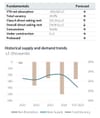WASHINGTON—The Urban Land Institute’s (ULI) latest Real Estate Economic Forecast released today predicts that the real estate sector is poised for a rebound, with the single-family housing sector, hotel and industrial returns forecast to strongly increase over the next three years.
The report’s conclusions are based on an April-May survey of 42 economists and analysts at 39 leading real estate organizations. The sentiment of the group indicated that the office sector is likely to rebound by 2023, and industrial will remain strong; meanwhile, other asset classes will rebound from pre-pandemic lows and grow in future years.
“While the fall 2020 Forecast was notable in its reversal of many of the pessimistic forecasts from spring 2020, the current forecast goes even further, with several forecasts now ahead of long-term averages,” said ULI Leading Member William Maher, director of strategy and research, RCLCO. “Among the 2021–2023 metrics predicted to outpace long-term averages are GDP and employment growth, the unemployment rate, real estate transaction volumes, warehouse and apartment occupancy and rent growth, and single-family housing starts and price appreciation.”
The survey results were released today during a ULI member-only webinar that also featured observations from Michael Acton, managing director, AEW Capital Management, L.P.; Matt Anderson, managing director, Trepp LLC; Lee Menifee, managing director and head of Americas investment research, PGIM Real Estate; and Suzanne Mulvee, senior vice president of research and strategy, GID.
Predictions from the semi-annual survey, which covers the forecast period of 2021 through 2023, include the following:
• U.S. GDP is expected to rise by 6.5% in 2021, up from -3.5% in 2020. It is expected to rise 3.9% in 2022 and 2.5% in 2023. This is an increase for 2021 over the October forecast, but a decrease for 2022.
• Net job growth is expected to increase by 5.5 million in 2021, a much more upbeat assessment over the October projection, but will taper off to 3.0 million in 2022 and 2.1 million in 2023 for a three-year total gain of 10.6 million jobs. The national unemployment rate is forecast to be at 5% for 2021, before dropping to 4.1% in 2022 and 4% in 2023, below the 20-year average of 6%.
• Expected yields on the 10-Year U.S. Treasury note are expected to gain rapidly over the next three years. In 2021, the expected 10-Year yield is predicted to be 1.95% in 2021, 2.23 in 2022 and 2.5% in 2023.
• Commercial real estate transaction volume is expected to recover relatively quickly through 2023, nearly reaching parity with 2019’s volume. 2021 is expected to see transaction volume at $500 billion, with 2022 at $550 billion. Expectations for CMBS issuance is $70 billion in 2021, rising to $85 billion in 2022 and $90 billion in 2023, both of which exceed the 20-year average of $82 billion.
Commercial real estate price growth as measured by the RCA Commercial Property Price Index is expected to remain below 2020 levels for all three years, dropping to 4.2% in 2021 and increasing to 5% in 2022 and 5% in 2023.
• Rent growth expectation for the next three years is expected to be uneven depending on the sector. Industrial rent growth continues to lead all sectors with an average of 3.6% between 2021-2023, followed by multifamily at 2.6%, retail at -0.1% and office at -0.3%. Hotel revenue available per room (RevPAR) is expected to strongly rebound for an average increase of nearly 20% over the three-year period the survey covered.
• National vacancy and availability rates are expected to again continue performing below the 20-year average for industrial and apartments, but above average for office. Over the next three years, availability for industrial will average 7.3%, below the 20-year average of 10.4%, and apartments will average 4.4%, below the average of 5.3%. Office vacancy rates are expected to rise by a three-year average of 16.2%, above the average of 14.3%, and retail will be slightly below average at 9.8%, below the average of 9.9%.
• The forecast for real estate returns as measured by the National Council of Real Estate Investment Fiduciaries (NCRIEF) Property Index for 2021 are higher than 2020 and will continue to rise throughout the next two years for office and retail. Total returns are forecast at 4.5%, 5.9% and 6.5% for 2021, 2022 and 2023, respectively. Industrial again leads all property types, with an average return of 9.8%, followed by apartment at 6.2%, office at 3.6% and retail at 2.5%.
• Housing starts exceeded the 20-year average in 2020 for the first time since the Great Financial Crisis. Housing starts are expected to continue to increase to 1.1 million in 2021, 1.2 million in 2022 and remain at that level in 2023.









